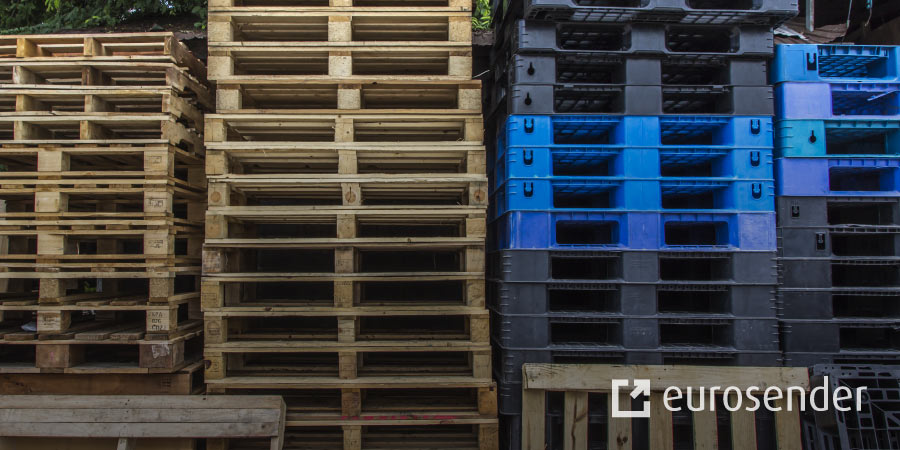What is the difference between plastic and wooden pallets?
Although wooden pallets are more commonly shipped than plastic pallets, there are pros and cons for each type of material. But when would you use a plastic pallet instead of a wooden pallet or vice versa? Find out the differences between plastic and wooden pallets regarding costs, industry, lifespan, and much more!
Jump to:
- Wooden vs plastic pallets: which is better?
- When would you use wooden pallets?
- Advantages/disadvantages of wooden pallets
- When would you use plastic pallets?
- Advantages/disadvantages of plastic pallets
- Summary – which is best?
- Eurosender pallet delivery solutions
Are wooden or plastic pallets better?
It depends. Generally, wooden pallets are a more versatile and easy option for most types of cargo.
Plastic pallets are better than wooden pallets for transporting products that require high levels of hygiene, and they are mostly used by the food and pharmaceutical industries.
When deciding which is better, consider also how the pallet will be used after shipping. Plastic pallets are a better choice than wooden pallets when they are likely to be returned to you after shipping. On the other hand, wood would be a better option than plastic if the pallet is not going to be sent back to you after shipping. This is linked to cost, which we will examine now.
Cost of plastic pallets vs wooden pallets
One of the biggest factors in the decision-making process is the cost of the pallet itself. Wooden pallets are cheaper to produce and more widespread than their plastic counterparts. This means that the initial cost for a wooden pallet is lower than a plastic pallet, which is especially important for smaller businesses.
However, plastic pallets may cost less in the long run because they have a much longer lifespan and are less prone to damage than wooden pallets. Despite this and other advantages of plastic pallets over wooden pallets, many businesses are deterred by the higher cost compared to wooden pallets.
Read more about:
- How to get pallet shipping quotes
- Standard pallet dimensions
- Access requirements for pallet shipping
When would you use wooden pallets?
Wooden pallets are by far the most popular type of pallet, accounting for 90-95% of all pallets. They are cheaper and easier to source than plastic pallets, and can be used to transport various types of cargo, from furniture to industrial machinery. See below the advantages and disadvantages of using wooden pallets for your shipment.
Advantages of wooden pallets over plastic pallets
- Wooden pallets cost about 3 times less than plastic pallets
- They hold more weight than plastic pallets, up to around 1,500 to 3,000 kg
- Easier to repair and, unlike plastic pallets, biodegradable
- High friction levels make wooden pallets stable and less likely to slip
- Easier to replace, making them a cost-effective solution for one-way shipments
Disadvantages of wooden pallets
- Compared to plastic pallets, wooden pallets are not suitable for fragile items
- Shorter lifespan: prone to bacterial or fungal infestation, rot, and other damage
- Unhygienic and unsuitable for transporting food or pharmaceuticals
- Chemical/heat treatment and documentation required for certain exports
- The mass production of wooden pallets contributes to deforestation
When would you use plastic pallets?
Plastic pallets are used for transporting fresh or frozen food, as well as pharmaceuticals and other products that require strict hygienic or temperature-controlled conditions.
If you ship items on a regular basis to the same client, it makes sense to invest in plastic pallets as they have a longer lifespan and can be returned to you after shipping. Additionally, reusable plastic pallets are light, weighing only about 70% of what traditional wooden pallets weigh, meaning that freight rates are generally lower.
Advantages of plastic pallets over wooden pallets
- More hygienic than wooden pallets and not prone to infestation
- Less risk of damage or injury due to the absence of nails and splinters
- Compared to wooden pallets, plastic pallets can withstand harsher weather
- Plastic pallets are not porous, making them easier to clean than wooden pallets
- No specific treatment or documentation required
Disadvantages of plastic pallets
- Plastic pallets cost about 3 times more than wooden pallets
- They are not suitable for transporting loads heavier than 680 kg
- Their sleek surface makes them slippery and less stable for stacking
- Plastic pallets are harder to repair than wooden pallets
- Not a cost-effective solution for one-way shipments
You may also be interested in:
In summary: are wooden or plastic pallets better?
When comparing the differences between plastic or wooden pallets, always consider factors such as your budget, cargo, and shipping frequency.
Check the tips below to help you make the right decision:
- If you are shipping items that have high hygienic standards, choose plastic pallets.
- For heavy shipments, wooden pallets are more suitable than plastic pallets.
- If you want a cheaper packaging option, choose a pallet made of wood instead of plastic.
- Plastic pallets are a more economical choice in the long run when they are returned after use.
In most cases, wooden pallets would be the best and simplest option for most logistics needs.
Can I ship plastic and wooden pallets with Eurosender?
Yes, you can ship wooden or plastic pallets on all of our freight services. Before shipping, we recommend considering the differences between plastic and wooden pallets to help you choose the right material. Please make sure to pack your pallet correctly so that it can be handled with a forklift or other lifting equipment.
If you need any information or advice about shipping your pallet, please don’t hesitate to contact us.
Interested in learning more about pallet and freight shipping? Check all our articles about pallet deliveries.
